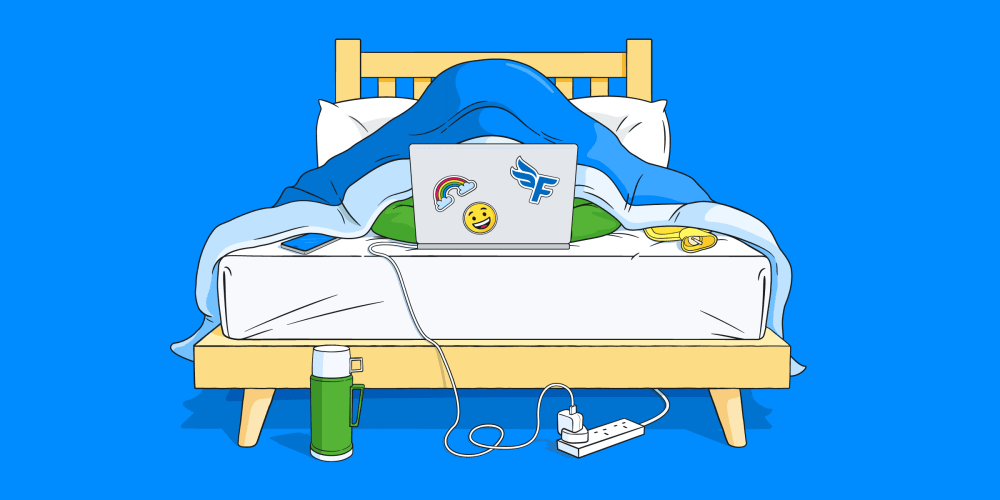Working from home expenses: how to save on gas and electricity bills

Working from home has many advantages but at this time of year, having to bear the extra cost of cranking up the heating and turning on the lights in the middle of the afternoon isn’t one of them.
If you’re reluctant to receive a shockingly-high energy bill just in time for Self Assessment, you might be thinking about wearing your winter woollies indoors to brave it through the cold, dark days. Fear not! If you're a sole trader, there is a more comfortable way to save on gas and electricity bills when you work from home.
Claiming tax relief on energy bills
As a self-employed individual, HMRC allows you to use a 'reasonable method' to claim a proportion of the gas and electricity costs in the part of your home that you use for business. Here’s how you might work it out:
1. Count all the rooms in your house
If your office is within your main home, count all the 'normal living spaces' in your home - in other words, all the rooms excluding bathrooms and hallways.
If your office isn't part of the main house and is billed separately (for example, you use a separate room in your garden), you should probably treat it as a one-roomed house, but do speak to your accountant for more help with tax reliefs if you have a separate garden office.
2. Identify the rooms that you work in
You need to work out what percentage of time spent in each room is business and personal. If you spend 10 hours a day in your living room, nine hours for personal time and one hour for business, then 90% is personal and 10% is business.
If you work in a dedicated room, such as a home office, you might only use that room for business. However, you should be aware that if you have an entire room dedicated to business use, you will almost certainly need to pay Capital Gains Tax on it if you sell your home.
3. Divide the cost of your bills between the rooms in your house
There is no official guidance on this calculation other than that your method should be 'fair and reasonable'. One suggestion could be to take each of your bills separately and then divide the cost evenly between the number of rooms in your house. For example, a five-room house with a gas bill of £460 will come to a cost of £92 per room (£460 ∕ 5 rooms = £92 per room).
Another method could be to work out the percentage of floor space for each room and multiply that by the total cost of the bill. For example, if your office takes up 10% of your home’s overall floor space and your electricity bill is £300, the room cost would be 10% x £300 = £30.
4. Apply the percentage of work use to the relevant room costs
So far you’ve worked out:
- the percentage of time you spend working in each room
- for each bill, the total cost that applies to each room
Now you can work out the business part of your gas and electricity bills and claim them as an expense on your Self Assessment tax return. For example, if you spend 90% of your time working in your home office and the total cost of heating that room is £92 you would claim:
£92 x 90% = £82.80 as business expenses
And if in the same room the cost of electricity is £30:
£30 x 90% = £27 as business expenses
All you need to do from here is add these costs as an out-of-pocket expense and then pay yourself back from your business account. That would save you tax on £109.80 saved on your energy bills. Not bad!
Can I use this method for other bills?
Yes, you can! Find out which expenses you can claim and how to claim expenses for the business use of your home.
The flat rate method
The flat rate method is a simple alternative if you don't want to calculate exactly how much energy you use working from home. It's available to sole traders and partnerships where the partners are individuals, but not to limited companies. You can claim a set amount of tax relief for the business use of your home depending on the number of hours spent working at home each month. The rates are:
| Hours spent working at home per month | Flat rate per month |
|---|---|
| 25 to 50 | £10 |
| 51 to 100 | £18 |
| 101 and more | £26 |
Bear in mind that tax relief calculated using the flat rate method might not be as high as the other methods suggested above.
Looking for an easy way to manage your business expenses? Start your 30-day free trial to get all your costs in order, so you’re ready for Self Assessment.
Originally published
Last updated
Disclaimer: The content included in this blog post is based on our understanding of tax law at the time of publication. It may be subject to change and may not be applicable to your circumstances, so should not be relied upon. You are responsible for complying with tax law and should seek independent advice if you require further information about the content included in this blog post. If you don't have an accountant, take a look at our directory to find a FreeAgent Practice Partner based in your local area.


